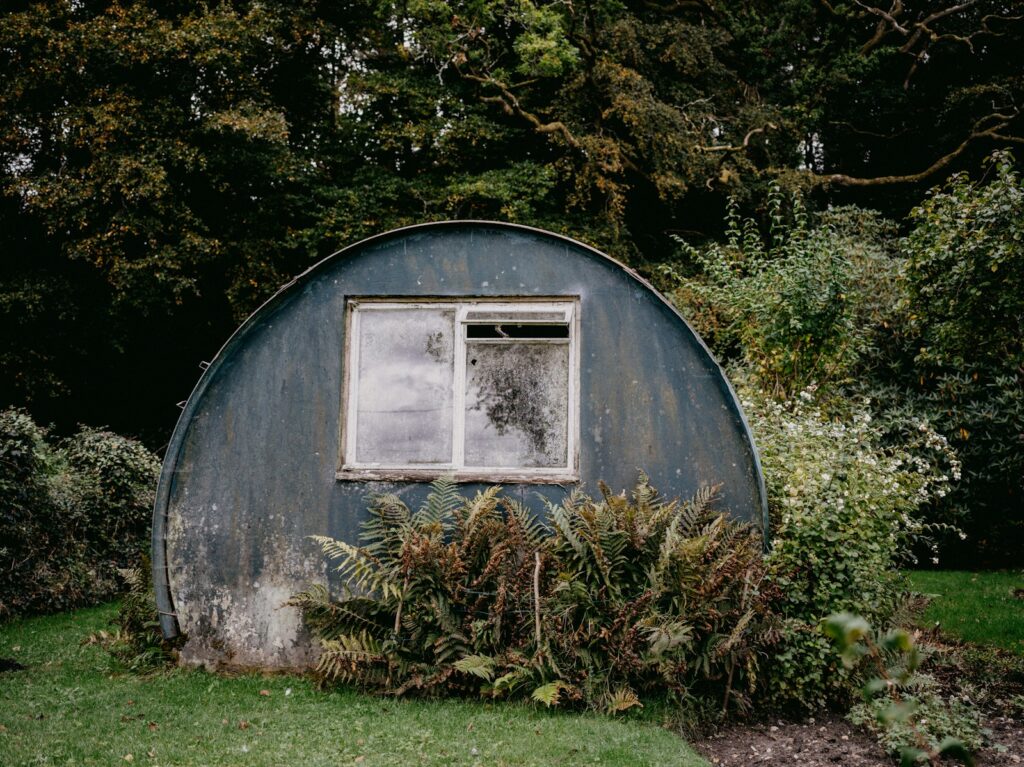CORNWALL’S COLD WAR RADIATION SHELTER.
Throughout the 1950s and early 1960s, the ever present threat of nuclear war evoked fear that permeated every level of society. Who can forget the constant depiction of nuclear mushroom clouds on television, the installation of neighbourhood air raid sirens, and school children being taught to dive under their desks and cover their eyes in air raid tests, to protect against the blinding light of a nuclear explosion?
Canada, like all NATO countries, implemented programmes to prepare for worst case scenarios, in face of the Soviet Union’s 30,000 nuclear bombs.
The Canadian government responded by creating the Emergency Measures Organization, responsible for planning, a few deep underground bunkers, for a Central Emergency Government Headquarters outside of Ottawa, which were dubbed “Diefenbunkers,” after then Prime Minister John Diefenbaker. Of the 50 constructed, Carp’s four story underground facility is by far the most elaborate. Intended to house vital government functions, many of these facilities were located in strategic and often remote places across Canada. Altogether there were nine classes of shelters, ranging from Carp’s 75 feet deep underground bunker, designed as self-sufficient community for the upper ranks of government, to much less “bomb proof” entities in the basements of government buildings, intended to house various government departments across Eastern Ontario, known as Federal Relocation Sites (Units).These were supplemented by separate Municipal Emergency Government Headquarters to protect local officials for several days after an attack, to coordinate rescue and reconstruction efforts.
Cornwall, due to its strategic location on the St. Lawrence Seaway with the Eisenhower Locks and the Hydro Power Dam, was in the front lines. In response to the threat of nuclear holocaust, two emergency shelters were built in Cornwall.
On June 27, 1960, Canada’s “first radiation fall-out shelter” built under the authority of the Emergency Measures Organization was formerly opened in Cornwall by Mayor L.G. Lavigne, on the south side of City Hall before an honour guard “composed of members of Cornwall Auxiliary Civil Defence Police,” led by inspector Keith Legault. The “Standard-Freeholder,” reported that the Mayor was accompanied by United Counties Warden John Fader, Emergency Services member, Councillor Larry Keen and many others and that Lavigne expressed approval of the model “shelter and wished the E.M.O. continuing success in its recruiting program.”
A LONE PROTEST.
Believing that war preparedness was not the answer, Queen’s University Arts student, Peter Tomlinson, picketed the event with a placard reading “Don’t Build Bomb Shelters, Build a Stronger U.N.,” in hopes of forming a local disarmament committee.
Not deterred by this plea, officials continued that, “The shelter was a joint effort of Counties Council, City Council and a local contractor,” and the “equipment was supplied on loan by local stores.” With material costs amounting to $200, this type of shelter was now “recommended” to homeowners. Now I am confused. Was the fallout shelter outside of City Hall or in the basement as I was once told? Any clarification of this point would be appreciated!
WHAT?
Is the reporter talking about the same shelter, or are they referring to “Basement Fallout Shelters,” the government was promoting at the same time, or are they one and the same? The story is not clear as Emergency Measures co-ordinator George Upfield said, in the same event, that the structure “is a fallout shelter only and not to be considered a nuclear bomb shelter,” as it would only reduce radiation.”
The ceremonies over, the public were invited to view the shelter.
Whatever the case may be the shelter on the south side of City Hall is long gone, and in the public mind, the Federal Relocation Unit, housed in the basement of the Post Office, now the home of the Public Library became the bomb shelter.
Retired Colonel Dave Peters, the former head of Canada’s civil defence readiness programme told the “Seaway News,” in September of 2012 that of the nine Federal Relocation Units built in Eastern Ontario, Cornwall’s communication centre “was the worst of them all,” due to the windows. Peters said that on learning of an attack, officials would only have 30 minutes before impact from an intercontinental ballistic missile to “…get plywood and cover the (large basement) windows and then cover” them with dirt.

The row of large windows along the western outside wall of the Federal Relocation Unit in the former post office, made this site an impractical shelter, as Civil Defence staff would not have been able to cover the windows before a ballistic missile struck.
A year later during “Doors Open,” local historian Chris Granger, told reporter Adam Brazeau, that the basement was intended as a government communications centre only, with other government offices in Arnprior, Carleton Place, Kemptville, Pembroke, Renfrew and Smiths Falls.
Other than as museums, today a shelter converted into temporary barracks at Canadian Forces Base in Valcartier, is the only Cold War facility still in use.
COLD WAR EMERGENCY SUPPLIES in the Federal Relocation Unit, which once housed a sleeping quarters, a command centre, a kitchen stocked with Campbell’s Gattuso Chicken soup, and it is believed, a small operating room.

Emergency crates of water, and wool blankets.

A stainless steel canteen with a cup/lid with its original wool cover and leather strap.The lid is stamped “Rigby & Mellor Ltd, 1956, Bury Lancs (Lancashire, U.K.).

Cotton Canadian Civil Defence First Aid Pack, 1957-58. Some of the contents of the pack are: a box of 12 – 4 inch x six yards gauze bandages made by Johnson & Johnson; 3 boxes of 5 triangular bandages; 12 safety pins; one pair of first aid scissors with lanyard; 11 Mark 111 trauma bandages; a tube of Pontocaine eye ointment; Canadian Civil Defence armbands, emblazoned with the word “Health,” and two pencils.(All photos courtesy of the Cornwall Public Library.)
A REMINDER: The idea for this article came from a reader. Please let me know if you have a topic about Cornwall or SDG’s history you would like to learn more about by contacting THE SEEKER.
Editor’s Note: The reader indicated that a current fallout shelter located at the Cornwall St. Lawrence Seaway Corporation in the Basement appears on the following fallout locations map: https://shorturl.at/vUpLx Any information on such a shelter would be welcome.





